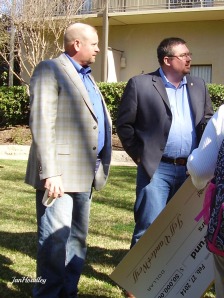
President of AgChat Foundation Jeff VanderWerf, right, with Secretary Ryan Weeks. Photo by Board Director Jan Hoadley commemorating $50,000 raised to help ranchers after Atlas
On April 7, 2009 the first #agchat was held for those in agriculture to discuss issues on Twitter. By the summer of 2010 over 2,500 people from four continents and eight countries have participated in AgChat and the ‘sister chat’, #Foodchat held the third Tuesday of each month. In the time since, several worldwide efforts have been made including helping to raise over $50,000 for ranchers affected by Atlas storm.
Over 800 farmers are listed in the database of Twitter’s follow a farmer listing. Several of these farmers knew all had stories so organized the AgChat Foundation. Seeking to reach out and empower others in the agriculture community with more effective tools, the first Agvocacy 2.0 Conference was held in August 2010 with 50 participants and 30 volunteers traveling from coast to coast and border to border to Chicago. In August the conference will be over 100 people, with a larger focus on broadening our reach.
Twitter is a forum that some find more difficult to use in it’s brevity, but those brief comments, or Tweets, of under 140 characters make it ideal to agvocate. It allows the sharing of tidbits of information, photographs from the farm and telling others why we do what we do.
“Oh but people don’t care about what happens on my farm!” Yes they do! As food recalls increase, sensationalized videos come to the media and people are told we should fear our food people DO care what is happening on our farms! They want to know what we’re doing, why we’re doing it, what we see and glimpses of our life that is more than just work.
As people learn small things about what we do it takes away the fear. Many do not know what we do to care for the environment around us until we show them. Knowledge is power and for far too long we have let others tell our story.
With Twitter because it is short bits of information farmers can text with their cell phone and share a new calf, status of fields or what the day’s chores hold for you. Still there are some important tips, shared at the first Agvocacy 2.0 Conference by California rancher Jeff Fowle and dairy farmer Ray Prock.
Be yourself is important. Find common interests with others and expand your communication circle. This can be effective to find others in agriculture but ultimately social media is a great tool to connect with consumers.
It appeals to the social nature of people to connect with others. One key point is talking *with* someone not *at* them. We aren’t giving lectures!
Describe honestly what you do from your perspective. Beware of too much unnecessary information. What you had for lunch most probably don’t care about! Nor do most care how much your power bill is or other personal information. However, where it applies to food production it may be relevant.
Basic etiquette is important If someone posts something you want to share – or Re-Tweet – an RT in front of the message copies it word for word. If you change the message or drop words out relay it as “via (whomever)” to give credit.
Twitter is primarily to communicate rather than self promotion. Engage people! Share a blog, an online article relevant to your farm, respond to your followers. If you are new post a few times with an introduction to #AgChat and you will likely meet plenty of people willing to help you along.
Other hash tags direct your messages to groups of interested people that may not follow you directly. A few of these might be #food #meat #dairy or #farm. Have an avatar to make it personal.
Use caution connecting with other social tools to your Twitter account Some can hijack your account or flood with unwanted messages.
If we don’t tell our story others will. Twitter can be a great tool to connect with and educate the majority of the people who eat every day. Make it interesting and social media need not take a great deal of time if managed just like other farm chores.

Leave a comment